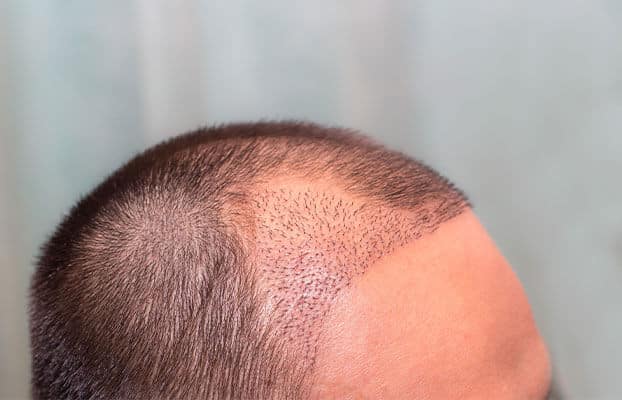Shock Loss After Hair Transplant: Understanding Temporary Shedding
Undergoing a hair transplant can be an exciting journey toward regaining a fuller head of hair. However, many patients experience “shock loss” after the procedure—a temporary shedding of hair in the weeks following surgery. While it can be unsettling, this is a normal part of the hair transplant recovery process.
Shock Loss After Hair Transplant: What You Need to Know
Hair transplantation is an effective solution for hair restoration, but one of the most talked-about phenomena following the procedure is shock loss. While the term may sound alarming, it’s a temporary and normal part of the recovery process for many patients. Here’s a comprehensive guide to understanding and managing shock loss after a hair transplant.

What Is Shock Loss?
Shock loss refers to the temporary shedding of transplanted and sometimes existing natural hair following a hair transplant procedure. This occurs due to the trauma that the scalp undergoes during the surgery, which can disrupt the natural hair growth cycle.
Shock loss can affect:
- Transplanted Hair: The newly grafted hair may shed before growing back stronger.
- Existing Hair: Hair near the transplant site may also shed, especially if it was already weak or thinning.
Why Does Shock Loss Happen?
Shock loss is primarily linked to the stress that the scalp endures during the transplant process. This can occur because:
- Trauma to the Scalp: The insertion of grafts and extraction of follicles can temporarily impact hair follicles.
- Change in Blood Supply: Surgical adjustments might alter the blood flow around hair follicles, causing them to enter the resting phase (telogen phase).
- Inflammation: Post-operative swelling or inflammation can trigger follicular shock.
When Does Shock Loss Occur?
Shock loss typically begins within 2–8 weeks after the hair transplant procedure. The duration and extent of the shedding vary among individuals, with most cases resolving within 3–4 months. Once the shedding phase passes, new and healthier hair growth begins.
Who Is Most at Risk?
- Younger Patients: Those with ongoing hair loss may experience shock loss in areas prone to thinning.
- High-Density Transplants: A densely packed transplant area may experience more trauma.
- Existing Fragile Hair: Hair already in the miniaturization phase (weakened by androgenetic alopecia) is more susceptible.
Is Shock Loss Permanent?
In most cases, shock loss is not permanent. The hair follicles remain healthy and resume normal growth within a few months. However, pre-existing hair that was already weak or thinning may not regrow if it was on the verge of permanent loss before the surgery.
How to Minimize Shock Loss
While shock loss cannot always be avoided, there are steps to reduce its likelihood or impact:
Choose an Experienced Surgeon:
- Proper technique minimizes trauma to the scalp and surrounding follicles.
Follow Post-Operative Instructions:
- Avoid touching or scratching the scalp.
- Use prescribed medications, such as anti-inflammatory or antibiotic creams, as directed.
Medications:
- Minoxidil or finasteride may help protect existing hair and encourage regrowth.
Scalp Care:
- Maintain gentle scalp hygiene and avoid harsh chemicals or products.
Healthy Lifestyle:
- Proper nutrition, hydration, and avoiding smoking/alcohol can support hair recovery.
What to Expect During Recovery
- Week 1–2: Some redness, swelling, and minor crusting may occur. Shedding may not yet be noticeable.
- Week 2–8: Shock loss may begin, with both transplanted and nearby natural hair shedding.
- Month 3–6: Hair regrowth starts to become noticeable.
- Month 6–12: Significant growth and improvement in hair density.
- Month 12–18: Final results, with thicker and more natural-looking hair.
When to Consult Your Surgeon
While shock loss is a common occurrence, consult your surgeon if:
- The shedding seems excessive or persists beyond a few months.
- You experience severe redness, pain, or infection.
- There’s no noticeable hair regrowth after 6 months.
Shock loss after a hair transplant can be unsettling but is a normal and temporary part of the recovery process. By choosing a skilled surgeon, following proper aftercare, and maintaining realistic expectations, you can navigate this phase with confidence. Remember, patience is key—your new hair will grow back stronger, giving you the results you’ve been waiting for.
FAQ: Shock Loss After Hair Transplant
What is shock loss?
Shock loss refers to the temporary shedding of transplanted and sometimes existing hair after a hair transplant. It’s a natural reaction of the hair follicles to the trauma caused by the surgery.
Is shock loss permanent?
No, shock loss is typically not permanent. The hair follicles remain intact, and new hair growth usually begins within a few months. However, hair that was already weak or in the late stages of miniaturization may not regrow.
When does shock loss occur?
Shock loss usually starts within 2–8 weeks after the hair transplant and can last for a few weeks to a couple of months.
Why does shock loss happen?
Shock loss occurs due to the stress and trauma the scalp endures during surgery. This can affect the hair growth cycle, causing some hairs to enter the resting phase (telogen phase) and fall out.
Can shock loss affect existing hair?
Yes, shock loss can affect existing natural hair near the transplant site, especially if the hair was already weak or thinning.
How long does it take for hair to regrow after shock loss?
Hair typically starts to regrow within 3–6 months after the shedding phase. Full results can take 12–18 months to appear.
Who is most at risk of shock loss?
- Individuals with thinning or weak hair near the transplant site.
- Patients undergoing large or densely packed transplants.
- Younger individuals with progressive hair loss.
How can I minimize the risk of shock loss?
- Choose a skilled and experienced surgeon.
- Follow post-operative care instructions carefully.
- Use recommended medications like minoxidil or finasteride to support hair growth.
- Avoid scalp trauma or harsh treatments during recovery.
Does shock loss happen to everyone?
Not everyone experiences shock loss. Its occurrence depends on individual factors like scalp sensitivity, hair health, and surgical technique.
Can shock loss be prevented?
While it’s difficult to completely prevent shock loss, proper surgical techniques, post-operative care, and medications can reduce its severity and duration.
Does shock loss hurt?
No, shock loss itself does not cause pain. However, you may experience mild scalp discomfort or sensitivity as part of the normal recovery process after the procedure.
Should I be worried if I experience shock loss?
Shock loss is a normal and temporary phase of the hair transplant process. However, if shedding is excessive or prolonged, consult your surgeon for reassurance and guidance.
What if my hair doesn’t regrow after shock loss?
If regrowth hasn’t occurred after 6–9 months, consult your surgeon. They may evaluate your scalp health and recommend additional treatments or medications.
Can medications help with shock loss?
Yes, medications like minoxidil and finasteride may help reduce shock loss and support quicker regrowth.
How can I care for my scalp to support regrowth?
- Avoid scratching or rubbing your scalp.
- Use only recommended shampoos and products.
- Protect your scalp from sun exposure.
- Stay hydrated and maintain a healthy diet.
When should I consult my surgeon about shock loss?
Contact your surgeon if:
- Shedding is excessive or persists beyond 3–4 months.
- You experience signs of infection, such as severe redness, swelling, or pain.
- Hair regrowth doesn’t start after 6 months.
How long until I see the final results of my hair transplant?
The final results typically appear between 12–18 months post-surgery, after the hair has gone through the full growth cycle.

















